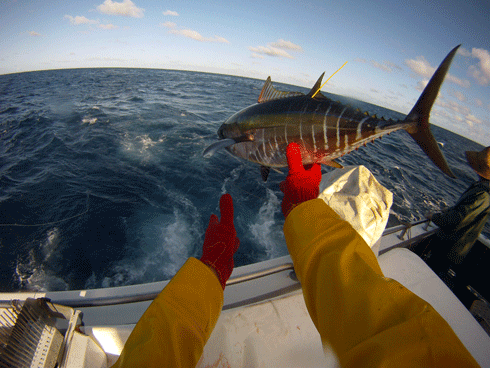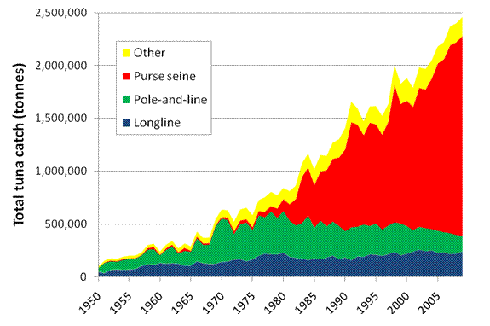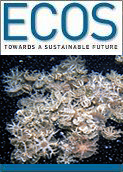
|
Published: 10 September 2012
Bigeye: Pacific tuna fishery with a future
In 2010, 60 per cent of the global tuna catch came from the Western and Central Pacific Ocean, the world’s biggest tuna fishery. At 2.4 million tonnes, the 2010 catch is the fishery’s second highest annual catch on record. So how much tuna is out there and is the amount of fishing sustainable?

|
|
A tagged bigeye tuna is released back into the Pacific Ocean from the RV Soltai 105 during its recent tuna tagging run through the waters around Papua New Guinea.
Credit:
Malo Hosken, SPC
|
The Secretariat of the Pacific Community (SPC) has been tagging tuna since the 1970s to collect critical information for the assessment of tuna species in the fishery.
The SPC is an international organisation providing technical and policy advice, training and research services to 22 Pacific Island countries and territories.
Its Pacific tuna tagging program is the largest ever implemented in the Pacific area and, with more than 300,000 tuna now tagged, it is generating the most comprehensive data set for tuna management in the world.
Running since 2006, the program is an initiative of the Pacific Islands community, who want to ensure the best information is available to manage their oceanic ecosystems.
With funding and operational support from Australia, New Zealand, France, the European Community, Korea, Taiwan and the Global Environment Facility, the program has tagged fish in Indonesian waters to the west across to French Polynesia in the central Pacific.
Tagging is currently focused in Papua New Guinean waters through funding from the PNG Government.
‘Tuna is hugely important to the region,’ says John Hampton, SPC’s Oceanic Fisheries Programme Manager. ‘Many Pacific Island countries and territories rely heavily on it for income through fishing licences.
‘This income was estimated at US$78 million in 2007, up 25 per cent from the previous estimate in 1999.
‘Local people rely on tuna for their livelihoods. Pacific Islanders consume more than twice the amount of fish per head of population than the world average and half of their recommended protein intake comes from fish.’
According to a 2009 report by the Asian Development Bank, most formal fisheries jobs in Pacific island countries are tuna-related and 10–20 times more people fish for subsistence than for commercial purposes.
‘We need to know how much tuna is out there and whether the amount of fishing is sustainable,’ says John Hampton.
Bigeye is one of the four main tuna species targeted by fishers in the Western and Central Pacific Ocean fishery; the others are skipjack, yellowfin and south Pacific albacore.
Though bigeye represents just 5 per cent of the total tuna catch, the species is being overfished, according to the SPC’s 2010 stock assessment released in January.
‘Overall, the fishery is in the best shape of all the tuna fisheries in the world’, says John Hampton. ‘On a scale of 1–10, we estimate it as 6–7, a green traffic light tinged with orange.
‘But there has been an upward trend in total tuna catch for many years, mainly due to increases in purse-seine fishery catches, which accounted for 75 per cent of the 2010 catch.
‘The amount of bigeye fishing needs to be reduced by about one-third from the present level to ensure long-term sustainability.
‘Most of the bigeye catch is taken in equatorial areas, both by purse seine and longline. The purse-seine fisheries and domestic surface fisheries of the Philippines and Indonesia take large numbers of small bigeye.’

|
|
Graph showing increase in annual tuna catches in the Western and Central Pacific Ocean fishery since 1960 – note the dramatic increase in catches from purse seine nets.
Credit:
SPC
|
Developing capacity within the Pacific Island community to monitor tuna stocks is an objective of the tagging program. SPC tagging crews, comprising almost all Pacific Islanders, have become the most experienced in the world.
As well as the conventional plastic tags, SPC crews also use electronic tags, depending on the size and condition of the tuna. The introduction of the electronic tags occurred through an earlier collaboration between the SPC and the CSIRO based in the Coral Sea.
Sonic tags are miniature radio-transmitting devices that are surgically implanted into the peritoneal cavity of the tuna. Tuna are known to congregate under floating objects and sonic tags are used to detect their presence near floating listening devices.
Archival tags are also surgically implanted. These miniature computerised data recorders can measure water pressure, water temperature, light intensity and the internal body temperature of the tuna.
Satellite tags have an advantage over archival tags in that they do not need to be recovered. Fixed to the back of the fish, they detach after a pre-set time, float to the surface and transmit the recorded information to a satellite.

|
|
Bruno Leroy (left) and Captain Eti Palu (right) tag bigeye tuna on board the RV Soltai 105.
Credit:
Malo Hosken, SPC
|
The data offers fascinating insights into how tuna behave.
We now know that they adjust the depth at which they swim to maintain an ideal body temperature. Each species has its own ‘favourite’ depth which shows up also in the different food they eat. Some individuals have been recorded diving to depths of more than 1000 metres, perhaps to avoid predators.
Nevertheless, recovering the tags remains a challenge in the vastness of the Pacific Ocean. Tagged fish are recaptured throughout the region, from Indonesia and the Philippines in the west, to the central Pacific near Tahiti and beyond. Some fish have been caught up to 4500 kilometres from where they were released. Others have turned up in factories as far apart as Thailand and Ecuador.
To raise awareness of the tagging program and to maximise the number of tags recovered, SPC communicates with fisheries authorities, major fishing associations and the tuna fishing industry in islands and countries throughout the region. It offers cash rewards to fishers as an incentive to return the tags and has distributed posters in 13 languages to show the different tag types, advertise the rewards, and tell people where to send the tags.
Lotteries are regularly run in local fishing ports, canneries and markets. In March, Johnathan Joul, a fisher from Kananam village, near Madang, won USD500 in a lottery to celebrate the recovery of SPC’s 50,000th tag. He spotted the yellow tag on the back of a yellowfin on board the Dolores 828, about 140 miles from where the fish had been released in the Bismarck Sea.
SPC video about the RV Soltai 105’s most recent voyage in PNG waters – the final PNG tagging cruise in 2013 will bring the total number of tuna tagged to over 100,000 for this one project.



